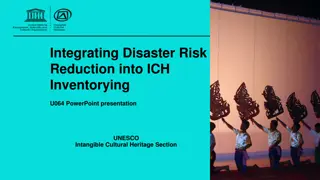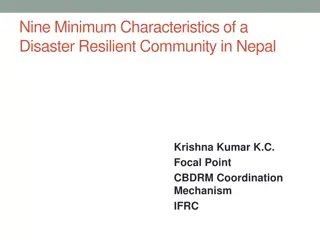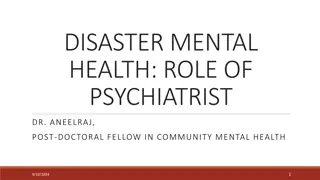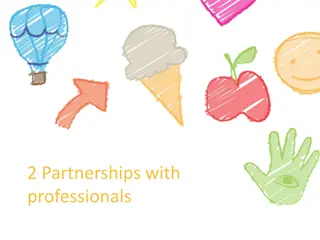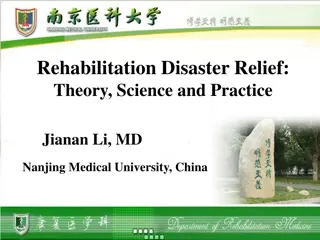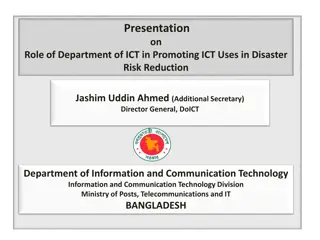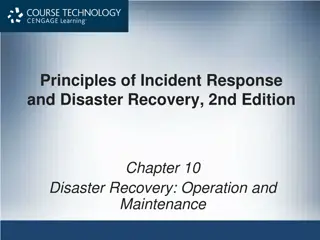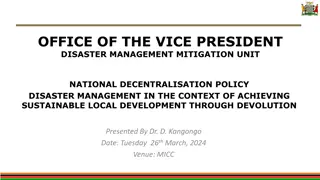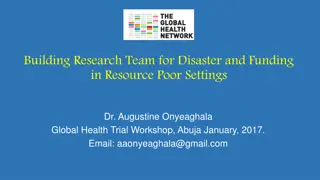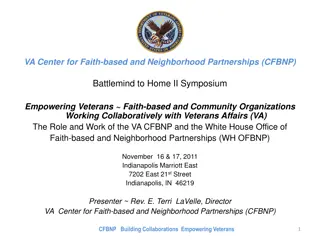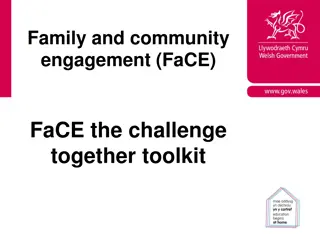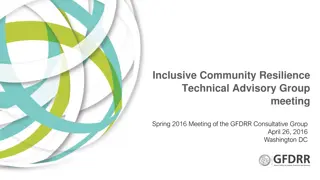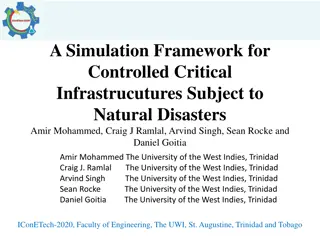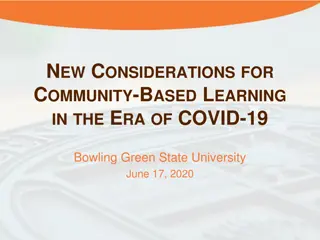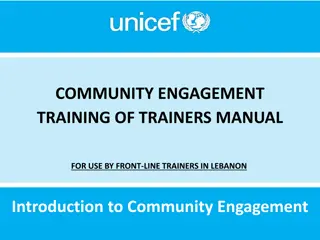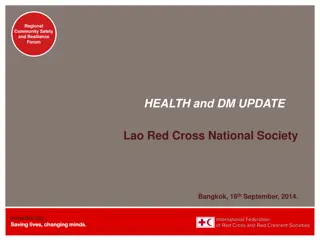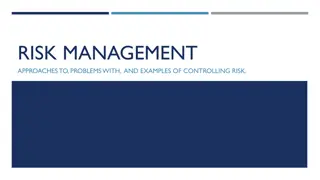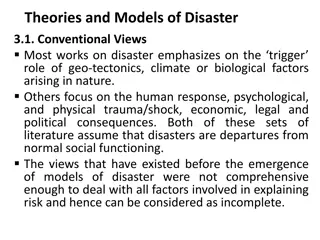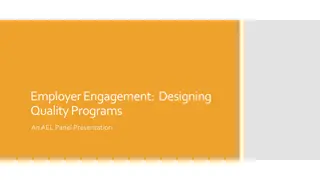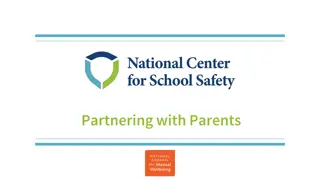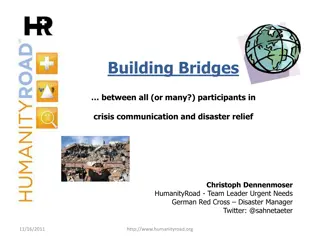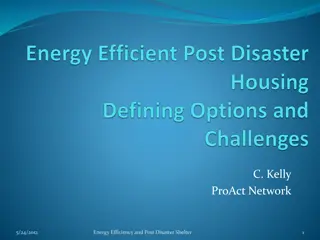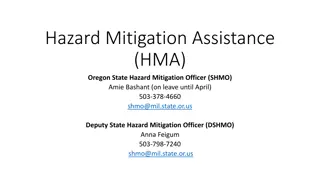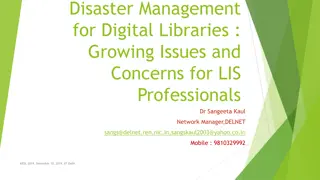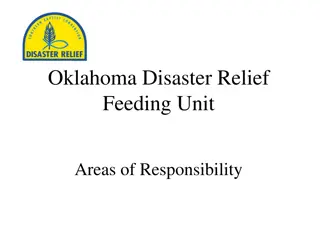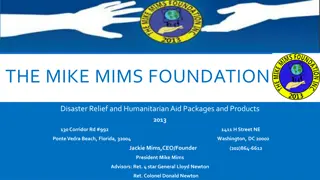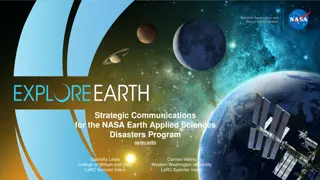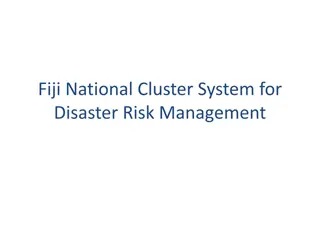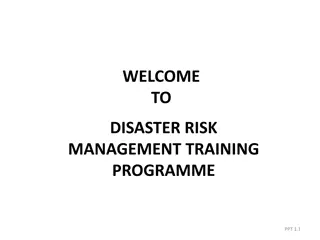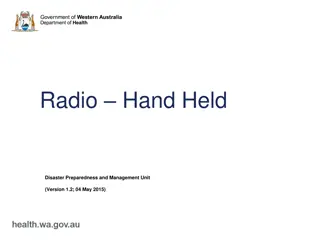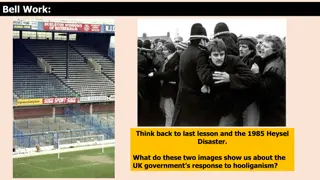Understanding Disaster Engagement and Community Partnerships
This unit focuses on the six-step Engagement Process for effectively involving faith communities in disaster response. It covers tools for assessing damage, engaging religious and cultural groups, and leveraging partnerships. Key aspects include understanding the situation, identifying impacted areas, assessing needs, and maintaining community engagement. Situational Awareness is emphasized for monitoring incidents and hazards. Various sources like Google Crisis Map, GeoPlatform, and local government reports help gather essential information.
- Disaster Engagement
- Community Partnerships
- Situational Awareness
- Faith Communities
- Cultural Landscape
Download Presentation

Please find below an Image/Link to download the presentation.
The content on the website is provided AS IS for your information and personal use only. It may not be sold, licensed, or shared on other websites without obtaining consent from the author. Download presentation by click this link. If you encounter any issues during the download, it is possible that the publisher has removed the file from their server.
E N D
Presentation Transcript
Unit 2: Understand the Situation and Leveraging Partnerships 1
Objectives Upon completion of this lesson, you should be able to: Explain the six step Engagement process for successfully engaging faith communities. Identify tools and resources for assessing disaster damage and religious and cultural communities in a geographical area. Describe the key partners that may be engaged during disaster operations. Identify religious symbols as a field skill for successful engagement 2
The Engagement Process Understand the Situation and Leveraging Partnerships Learn Your Religious and Cultural Landscape Assess Your Knowledge Develop an Engagement Plan Maintain and Sustain Leader and Community Engagement Continuously Review and Improve Your Engagement Plan 3
Discussion - Understand the Situation The first step in the engagement process is to obtain an understanding of the current situation. What sources can be used to get this information? 4
Understand the Situation Determine the areas that were impacted Google Crisis Map (http://google.org/crisismap/weather_and_events) GeoPlatform (http://www.geoplatform.gov/) for Federally declared disasters State or local resources Preliminary Damage Assessments (PDAs) Geographic Information System (GIS) maps Emergency Operations Center (EOC) Briefings from locals Additional applications 5
Understand the Situation (cont'd) Determine how the people in those areas were impacted Determine their current needs Review the local government and/or voluntary agency Situation Reports 6
Situational Awareness (SA) The ability to identify, process, and comprehend the critical information about an incidentknowing what is going on around you [requiring] continuous monitoring of relevant sources of information regarding actual incidents and developing hazards (National Response Framework) 7
Obtaining SA Know where to look in the Emergency Operations Plan (EOP) Ask the right questions based on your objectives Have a clear understanding of what information is important to gauge response and resourcing. 8
Obtaining SA Know who to contact Voluntary Agency Liaisons (VALs) FBOs, CBOs, Tribal, National VOAD First responders Develop standard protocols and procedures for receiving SA on a routine basis. Dont be afraid to speak up when you are not sure about the next step, your responsibilities, formal procedures, or objectives. 9
Secondary Hazards Occur due to the occurrence of another hazard Examples Landslides or tsunamis after an earthquake Toxic smoke from a fire 10
Some Key Partners in Emergency Management National Voluntary Organizations Active in Disaster (National VOAD) Nonprofit, nonpartisan, membership-based organization Serves as the forum where organizations share knowledge and resources throughout a disaster Majority of the national members have a religious affiliation (approximately 37 of 59 as of May 2017). www.nvoad.org Long Term Recovery Organizations (LTROs) Other Memorandum of Agreement (MOA) organizations 11
Some Key Partners in Emergency Management (continued) Houses of Worship and Emerging Cultural Communities Groups of people come together to perform acts of devotion veneration, or religious or cultural study. DHS Center for Faith-based & Neighborhood Partnerships (DHS Center) Created in 2006 by executive order Help emergency managers effectively engage with houses of worship and emerging cultural communities Delivers training and technical assistance to faith and community-based organizations Provides subject-matter expertise to help communities successfully partner with other emergency management components https://www.dhs.gov/dhs-center-faith-based-neighborhood-partnerships 12
Discussion - Key Partners Have you worked with any of the key partners we discussed? Please share your experience. 13
Beginning the Engagement Process As you begin engagement, you will want to be able to identify who is or was living in the home This provides you with a starting point for determining appropriate interactions and engagement 14
Activity 2.1: Identifying Religious Symbols Purpose: Identify religious symbols on homes and houses of worship Estimated Time: 5 minutes Instructions: 1.Locate Worksheet 2.1 in your Student Manual. 2.Identify the religion represented by each symbol. 16
Common Religious Symbols z Christianity Buddhism Judaism Hinduism Islam Roman Catholicism and Christian Orthodox 17
Identifying Religious Symbols (continued) 19
Identifying Religious Symbols (cont'd) Congregations may have changed denominations or faith traditions after being built Do not make assumptions based solely on the appearance of the building 20
Discussion: Engagement Plan (Part 1) Locate the sample Engagement Plan in the Student Manual. Review the following sections: Disaster Type Situational Awareness Community Awareness Goal Statement Questions: What tools or resources would you use to answer the questions in the Situational Awareness and Community Awareness sections? Is there any other information you might include? How might this information differ from FEMA's point of view vs. a religious leader's point of view? What is the importance of the Goal Statement? 21
Lesson Summary You should now be able to: Explain the six step Engagement process for successfully engaging faith communities. Identify tools and resources for assessing disaster damage and religious and cultural communities in a geographical area. Describe the key partners that may be engaged during disaster operations. Identify religious symbols as a field skill for successful engagement 22












